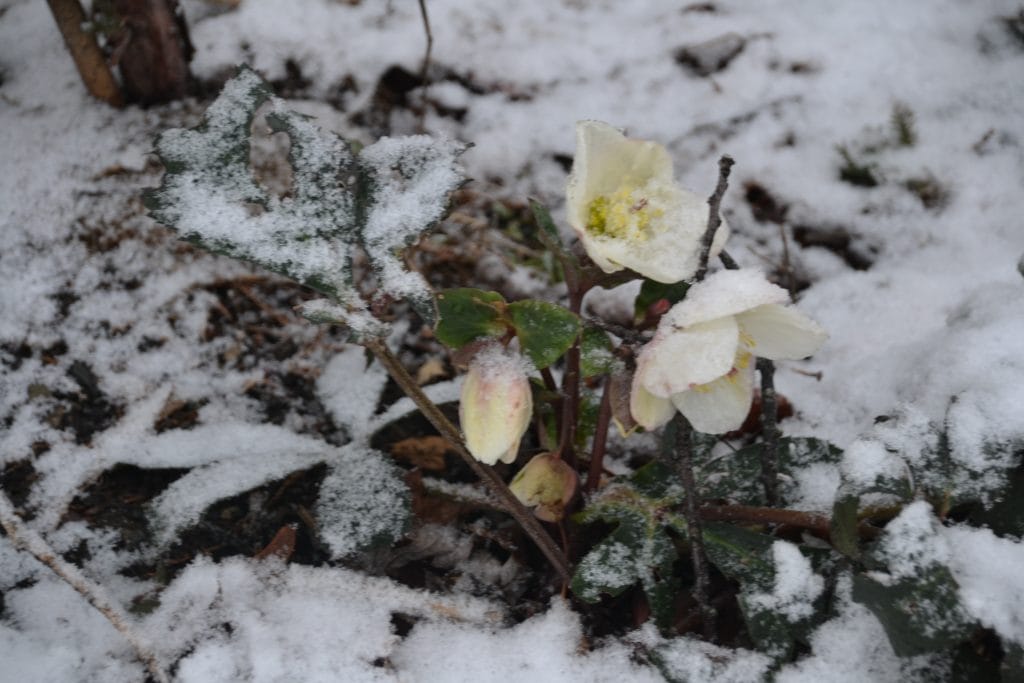Here’s what’s blooming in town this week to make your walks more enjoyable
By Laura Eisener
Feb. 2 has been known since the Middle Ages as a Christian celebration called Candlemas. From sundown Feb. 1 until sundown Feb. 2, early Gaelic pagan religions celebrated Imbolc. It is halfway between the winter solstice and the spring equinox, so in the northern hemisphere people consider it the midpoint until spring. The United States and Canada celebrate Feb. 2 as Groundhog Day, but the groundhog (also called marmot or whistle pig) is not native to Europe, so there they may choose a different burrowing and hibernating mammal, such as the European badger (Meles meles) or the West European hedgehog (Erinaceus europaeus) to predict the coming of spring warmth. If I were a Saugus groundhog, I would not come out to check my shadow for a while yet. There have been no tracks in the snow where the groundhog excavated a burrow underneath my bulkhead last fall, so I assume she or he is still happily hibernating.
Outdoors in New England, few flowers are blooming. I have been looking for signs of snowdrops (Galanthus nivalis), which are among the earliest late winter bulbs, but have not yet seen any in my yard or other peoples’. One of the names of snowdrops (Galanthus nivalis) is Candlemas bells, since in much of Europe they often bloom around now, and occasionally I have seen them this early here. My Christmas rose (Helleborus niger), which was in almost full bloom at Christmas, is fully open now, undeterred by the snowstorms early this week. Winter flowers seem often to bloom in slow motion. Most individual flowers in warmer weather would go from bud to bloom to gone by in two weeks or less, though the plant might continue to produce new blooms for a longer period.
Feb. 4 last year was the notorious day when the temperatures plunged from 20°F into negative numbers overnight, killing many spring flower buds like forsythia, azalea and magnolia so that these plants had very few blossoms in April and May. So far weather predictions have not suggested anything that drastic for this year, but you never know. One good result was that overwintering eggs of certain pesty insects were killed by the cold, in particular the hemlock woolly adelgid, which has for decades been killing Canadian hemlocks (Tsuga canadensis), which is a shade-tolerant native evergreen in much of New England and also a popular ornamental tree in gardens, often pruned as a hedge. In many places around Saugus, there are formerly beautiful but now dead hemlock hedges, and other places where gardeners struggle to keep their hedges or full-sized trees alive by having them sprayed annually. Perhaps these surviving hemlocks will get a break from these insects and from elongated hemlock scale, which has also threatened them in recent decades.
Indoors, tropical flowering bulbs like amaryllis (Hippeastrum spp.) are providing something to look forward to. At Dee LeMay’s house in East Saugus, there may be bare twigs outside the window but inside are promising amaryllis buds rising from the bulbs. At my house, some from previous years seem about ready to flower any day; two others have only emerged a couple of inches from the soil; and a few others still don’t have much green at all. Once the buds begin to come up, they need water and light. The taller stalks have to be turned once every day or two to keep them from leaning so far over they might break. Plants’ natural tendency is to lean toward the sun, so they will straighten themselves out if you rotate the pot to make them lean away from the window; then they adjust themselves again. If the stalks are extremely tall, you might give them the extra support of stakes. This often happens when the short days or a north facing window provides less than the optimum amount of light. If the worst happens and the stalks break, you can cut them and put them in a vase of water.
Editor’s Note: Laura Eisener is a landscape design consultant who helps homeowners with landscape design, plant selection and placement of trees and shrubs, as well as perennials. She is a member of the Saugus Garden Club and offered to write a series of articles about “what’s blooming in town” shortly after the outbreak of the COVID-19 pandemic. She was inspired after seeing so many people taking up walking.



